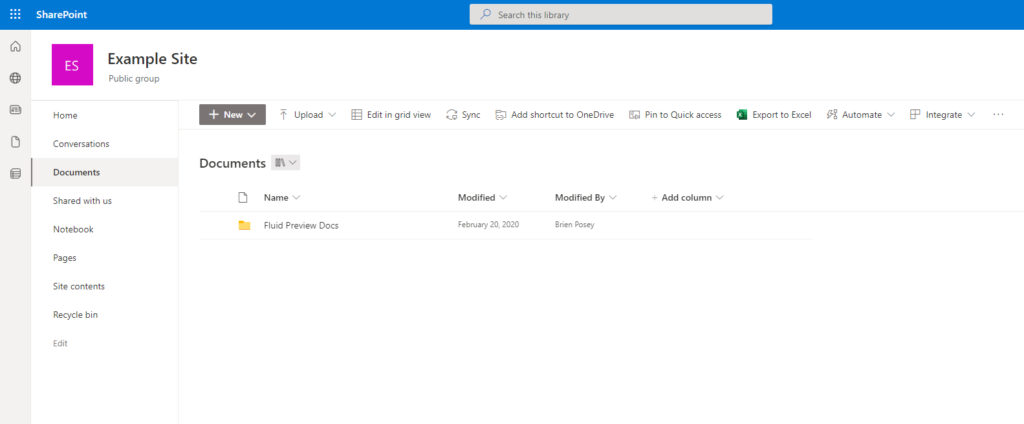Microsoft offers you several options if you want to store unstructured data files in the cloud. Two of the more popular options for enterprise file storage are SharePoint Online and Azure Files. Even though both of these platforms are suitable for file storage, they’re vastly different. The real question, is which one should you be using? In this article, I’ll examine the various use cases for these two file storage platforms.

SharePoint Online vs. Azure Files
SharePoint Online is a part of the Microsoft 365 suite and primarily functions as an online collaboration platform. Users are able to create SharePoint sites and store files within site libraries.

Azure Files, on the other hand, is a fully managed, cloud-based file server. Azure Files functions similarly to an on premises file server, except that there is no server to manage. In this case, Microsoft handles all of the low level maintenance on your behalf.

Both SharePoint Online and Azure Files are able to act as cloud-based file repositories. Below I’ll detail key considerations you need to take into account before you decide on the one you wish to use.
Key Considerations
You must consider several key factors when deciding which storage platform to use. This includes considering; use case, limitations, cost, and access method. Let’s, starting with use case take a look at each and why they’re so important.
Use Case
SharePoint Online can store any type of file, but it works best for storing documents. After all, SharePoint functions primarily as a collaborative platform within the Microsoft 365 suite. To this end, it makes sense that it’s an ideal document repository.
Azure Files is more of a general purpose file server. Like SharePoint Online, it does allow for file sharing. That said, it wasn’t designed specifically to help you collaborate. It’s also worth noting that Azure Files works well for programmatic file storage. If for instance, you have an application that needs to write data like log files, to a UNC file, Azure Files can easily meet that need.
Limitations
Some of SharePoint’s limitations vary by subscription, but here are some key points that apply to all SharePoint Online subscriptions:
- The maximum storage per site collection: 25 TB
- Total number of site collections per organization: 2 million
- The maximum size of an individual file: 250 GB
Azure Files doesn’t use the concept of sites or site collections, so you won’t have comparative metrics to use. Even so, an Azure file share does have a capacity limitation of 100 TB per UNC file share. This assumes that Microsoft’s newer, Large Shares feature is in use.
Let’s now take a look at cost of each file storage solution.
Cost
When deciding on a file storage platform organizations you must also consider how much it will cost to store the organization’s data. Most Microsoft 365 subscriptions include 1 TB of storage, plus an extra 10 GB for each licensed user.
This means that an organization with 1000 users would receive approximately 11 TB of storage space to be shared among the users. Microsoft does provide an option for subscribers to purchase additional storage space, but the cost varies by subscription.
Azure Files is based on a pay as you go pricing model. The storage cost varies based on a large number of factors like the redundancy used, snapshots in use, the region, and whether or not the organization is using reserved capacity. The storage tier also impacts pricing.
As a baseline estimate data at rest in the Hot tier or US 2 region is currently priced at $0.0255 per GB per month used. 10 TB of capacity reserved in the same region and tier currently costs $214.09 per month.
Now let’s discuss accessibility, as even the most cost effective tool with acceptable limitations needs to be used.
Accessibility
As previously mentioned, Azure Files is a cloud-based managed file server. This means, the data that is stored in Azure Files is accessed through a protocol such as SMB or NFS. As such, files can be accessed through a mapped network drive.
It’s possible to map a network drive to a SharePoint Online document library or to access a document library through File Explorer. While both were at least somewhat common practices in the past, Microsoft now discourages organizations from doing so.
As an alternative, Microsoft recommends that organizations who need SharePoint access through File Explorer create a sync relationship. This creates a local file copy that is kept synchronized with the document library’s contents. Of course the main option for accessing files saved in a SharePoint document library is to open the corresponding team site in a browser.
Possible Alternatives
SharePoint Online and Azure Files are both good options for file storage. It’s also perfectly acceptable for an organization to use something completely different. For instance, an on premises file server or NAS are options you can use. Of course, third party options are also available to you.
Final Thoughts
SharePoint tends to be better suited to document collaboration, while Azure Files offers a higher storage capacity and is the best option for files that need to be accessible through a UNC file share. Of course you’ll also need to consider platform limitations and costs to your organization.
Do you have more questions about SharePoint Online or Azure Files? Read the FAQ and Resources below!
FAQs
Why does Microsoft want users who need File Explorer access to SharePoint Online to use Sync?
The main alternative to Sync is View in File Explorer. When a user opts for the View in File Explorer option, Windows creates a temporary folder by which SharePoint data is accessible. That said, this folder only provides access for the duration of the session. In contrast, Sync relationships persist across sessions.
Are there any limits to the types of files that can be saved to SharePoint Online?
SharePoint was very strict about the types of files that could be saved within a document library. Over time, however, Microsoft has removed these limitations. No file type restrictions exist currently.
Can my organization use OneDrive or OneDrive for Business instead of SharePoint Online?
Both b and OneDrive for Business allow users to save files in the cloud. Even though a user can use these platforms to share a file with someone else, OneDrive and OneDrive for Business are better suited to individual file storage than to use in collaborative environments.
Will saving documents to Azure Files stand in the way of user collaboration?
Even though Azure Files isn’t a collaborative environment per se, it doesn’t prevent users from collaborating. This is so long as the proper access permissions exist. Users simply access files directly from a file share rather than going through an application such as SharePoint.
Which is better suited for low bandwidth environments, Azure Files or SharePoint Online?
If an organization is suffering from low bandwidth then Azure Files may be the better option; but not by itself. Microsoft offers a tool called Azure File Sync that allows Azure Files data to be cached on premises, in this way improving performance for low bandwidth environments.
Resources
Microsoft: Article on How to Customize SharePoint Online
Learn how to customize a SharePoint team site for file storage and sharing here.
TechGenix: Article on SharePoint Management
Read more on how to manage SharePoint from the Microsoft 365 Admin Center here.
TechGenix: Article on SharePoint Backups
Find out how to back up your SharePoint data here.
TechGenix: Article on Azure Data Protection
Discover why your business data is safe on Microsoft Azure here.
Microsoft: Documentation for Azure Files
Find Microsoft’s official documentation for Azure Files here.
Microsoft: Guide on Azure Files Planning
Access Microsoft’s planning guide for Azure Files here.




Both are good as cloud storage but the question that we should ask is, how can I transfer easily, safely, and quickly to any of these?
For me I would suggest ShareGate or Gs Richcopy 360, both have a good reputation in this field .